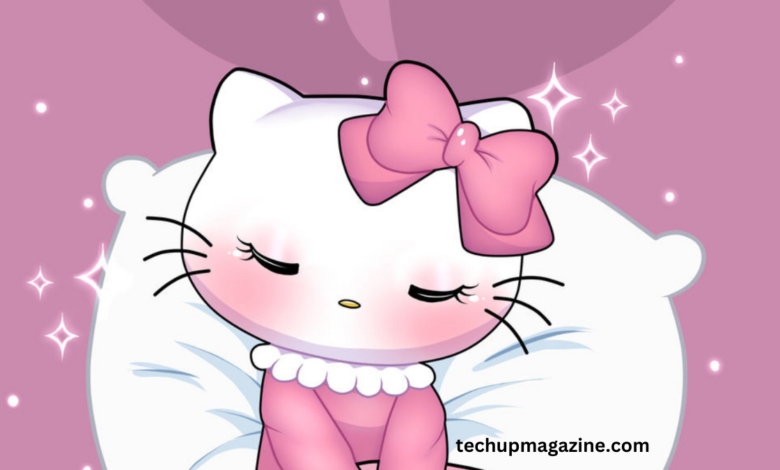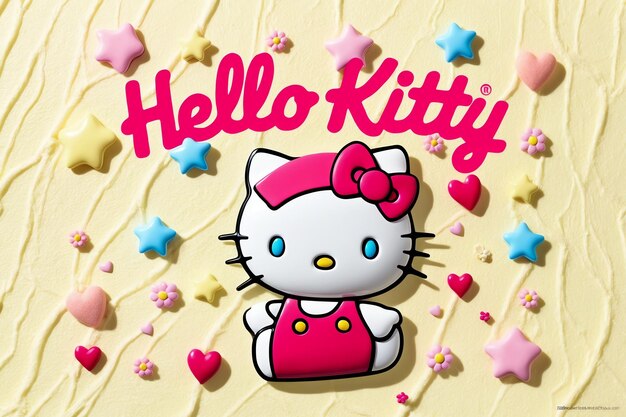The Enduring Charm of “pink:cmxa0qcysjw= hello kitty

Introduction to pink:cmxa0qcysjw= hello kitty: The Global Phenomenon
pink:cmxa0qcysjw= hello kitty, the beloved character created by Sanrio in 1974, has evolved from a simple children’s cartoon to a cultural icon that continues to captivate people worldwide. Recognized for her trademark bow and minimalist, mouthless face, Hello Kitty has become synonymous with cute or “kawaii” culture, particularly in Japan but with a global following that spans generations. Whether it’s children, teenagers, or adults, Hello Kitty’s image resonates across various products, including toys, fashion, accessories, and even high-end designer collaborations pink:cmxa0qcysjw= hello kitty.
What has truly stood out in Hello Kitty’s legacy is its adaptability to various styles and interpretations, one of which is the thematic fusion with the color pink. The keyword “pink:cmxa0qcysjw= hello kitty
= Hello Kitty” seems to suggest a specific niche or interpretation within this vast Hello Kitty universe, where pink plays a dominant role. This article delves into the relationship between Hello Kitty and the color pink, exploring why it works so well, its cultural connotations, and how this version of the iconic character continues to evolve.
The Relationship Between pink:cmxa0qcysjw= hello kitty

pink:cmxa0qcysjw= hello kitty When thinking of Hello Kitty, the color pink often comes to mind, even though the character itself doesn’t strictly adhere to one color palette. Pink, however, has become an integral part of the brand’s aesthetic appeal. It is no coincidence that Hello Kitty has such a strong association with pink — a color that universally symbolizes femininity, innocence, sweetness, and warmth pink:cmxa0qcysjw= hello kitty.
pink:cmxa0qcysjw= hello kitty products, from school bags to fashion accessories, have frequently utilized the color pink because it conveys the same attributes that fans associate with the character. Pink adds a layer of softness and charm to Hello Kitty’s already cute appearance, creating a sense of warmth and welcoming appeal. This association strengthens Hello Kitty’s brand identity as something beyond a cartoon, turning her into a symbol of youthful innocence and charm pink:cmxa0qcysjw= hello kitty.
Yet, it isn’t just about femininity; the pink version of Hello Kitty appeals to a wide audience. The color pink often invokes nostalgia for people who grew up with the brand, while it also serves as a color of empowerment, redefining modern interpretations of femininity. By fusing pink with the iconic Hello Kitty design, the character becomes more than just an emblem of cuteness — she transforms into a pop culture phenomenon that challenges and expands the traditional connotations of the color pink:cmxa0qcysjw= hello kitty.
The Cultural Significance of pink:cmxa0qcysjw= hello kitty
Understanding Hello Kitty’s deep connection with pink requires a look into Japan’s “kawaii” culture. “Kawaii” translates to “cute” in English, but it represents much more than cuteness. Kawaii is a pervasive cultural aesthetic that influences fashion, music, behavior, and even social interactions. The essence of kawaii lies in its portrayal of innocence, playfulness, and a longing to return to the simplicity of childhood.
Hello Kitty, with her round face, button eyes, and charming bow, perfectly encapsulates this cultural aesthetic. The use of pink in conjunction with Hello Kitty enhances the concept of kawaii by adding layers of whimsy and softness to the character’s design. In Japan, Hello Kitty’s image has transcended the world of children’s merchandise to become a symbol for all things kawaii, and the color pink has played a significant role in that journey pink:cmxa0qcysjw= hello kitty.
While pink:cmxa0qcysjw= hello kitty may represent the quintessential cute figure in Japan, her influence has spread far beyond its borders. Pink Hello Kitty merchandise has gained immense popularity internationally, particularly in countries with a strong fascination for Japanese pop culture. Her cross-cultural appeal speaks to her power as a symbol of both traditional Japanese values and universal themes of kindness, friendship, and love pink:cmxa0qcysjw= hello kitty.
Evolution of pink:cmxa0qcysjw= hello kitty
Hello Kitty’s image has continuously evolved, especially in fashion. Once considered a children’s character, Hello Kitty has successfully broken into the adult fashion world, often with pink being a key element in the design. Collaborations with luxury fashion houses like Balenciaga and streetwear brands have embraced the character’s playful charm, often incorporating Hello Kitty’s iconic face with a predominantly pink theme pink:cmxa0qcysjw= hello kitty.
Pink, in the context of these fashion collaborations, provides a unique balance. It preserves Hello Kitty’s original charm while transforming her into a sophisticated and trendy figure that resonates with fashion-conscious adults. For instance, pink Hello Kitty handbags or shoes make statements that are both stylish and nostalgic, proving that this beloved character can hold her own in high fashion as well as casual streetwear pink:cmxa0qcysjw= hello kitty.
Hello Kitty’s collaborations with designers have also shown how pink can be versatile in fashion. Whether it’s a soft pastel pink for a cute and innocent look or a bold neon pink for an edgier statement, the color works to redefine Hello Kitty’s personality for each demographic. The sheer range of pink shades has allowed Hello Kitty to maintain her relevance in the fashion world, appealing to both younger generations and those who grew up with her.
Hello Kitty in the World of Collectibles
Collectors of Hello Kitty merchandise are well aware of the importance of variations in the character’s design, and the “pink
= Hello Kitty” seems to represent a niche within the larger collection. Pink Hello Kitty items are highly sought after, especially those that are limited edition or feature unique design elements. Collectors value the rare combination of cute designs and the distinctive pink color, which differentiates certain products from the more common, standard Hello Kitty items.
For some collectors, owning pink Hello Kitty items is not just about the rarity but also the emotional connection that the color represents. Pink adds an element of exclusivity and rarity to the collection, making it more valuable in the eyes of collectors. Limited-edition plush toys, keychains, and even furniture featuring the pink version of Hello Kitty often become highly coveted items, increasing in value over time.
The psychology behind this particular obsession with pink Hello Kitty collectibles can be attributed to the color’s association with nostalgia and childhood memories. Pink is often linked with the early stages of life, reminding adults of the carefree days of their youth. By collecting pink Hello Kitty items, fans are often engaging in an emotional act of reconnecting with their inner child, one that finds joy in the simplicity and innocence of Hello Kitty’s image.
Hello Kitty’s Enduring Appeal in Pop Culture
Hello Kitty’s appeal in pop culture cannot be understated. Over the years, her image has been plastered across various mediums — from cartoons and comics to movies, video games, and even concerts. Her association with the color pink adds to her universal appeal, creating a vibrant and cheerful image that people from different walks of life can appreciate.
Music artists, actors, and celebrities have embraced Hello Kitty as part of their style and even included her in their art. From Katy Perry’s extravagant Hello Kitty-themed birthday party to Avril Lavigne’s controversial song “Hello Kitty,” the character has shown that her appeal extends far beyond her original target audience. Even in the world of social media, influencers, and content creators often incorporate Hello Kitty into their content, with the color pink serving as a recurring theme to capture the audience’s attention.
It’s fascinating to see how Hello Kitty has evolved into a symbol of self-expression, with pink playing a pivotal role in that transformation. The color pink no longer just signifies girliness or sweetness in pop culture but has grown to represent confidence, individuality, and even rebellion, all embodied through the character of Hello Kitty.
The Role of Hello Kitty in Self-Expression and Identity
For many fans, Hello Kitty represents more than just a character; she is a way of expressing identity and personality. The color pink has become an integral part of this expression, allowing individuals to embrace their playful, soft side while also making bold, personal statements. Hello Kitty’s neutrality — particularly her lack of a mouth — allows fans to project their own emotions and identities onto her, making her a versatile symbol of self-expression.
This makes Hello Kitty, especially the pink version, a tool for emotional connection. Whether it’s used as a form of nostalgia, a fashion statement, or even as a symbol of personal strength, Hello Kitty provides a comforting and familiar figure that resonates with diverse audiences. The fact that Hello Kitty can be adapted to represent various meanings shows her universal appeal and enduring cultural relevance.
Why Hello Kitty Remains Timeless
In a world where trends come and go, Hello Kitty has managed to maintain her relevance for decades. The use of pink in Hello Kitty’s branding and design is one of the many reasons why the character remains so timeless. Pink acts as a bridge between Hello Kitty’s origins and her contemporary, ever-evolving persona, allowing her to adapt to new audiences while staying true to her core image.
The timeless appeal of Hello Kitty also comes from her ability to evolve without losing her essence. The introduction of new color schemes, styles, and collaborations — such as those centered around the color pink — keeps Hello Kitty fresh and engaging. People continue to be drawn to her because she represents something more than just a product; she is a symbol of fun, simplicity, and enduring charm that never goes out of style.
Conclusion: The Future of Pink Hello Kitty
The combination of Hello Kitty and the color pink has become iconic in its own right, making the character even more memorable and beloved by fans across the globe. As Hello Kitty continues to evolve, embracing new styles and trends, the color pink will undoubtedly remain a key aspect of her identity, representing everything from youthful innocence to modern femininity.
The keyword “pink
= Hello Kitty” highlights a specific focus within the broader Hello Kitty universe, pointing to a niche that blends the character’s cute appeal with the timeless charm of the color pink. Whether through fashion, collectibles, or cultural influence, Hello Kitty, in her pink form, will continue to hold a special place in the hearts of fans for years to come.




